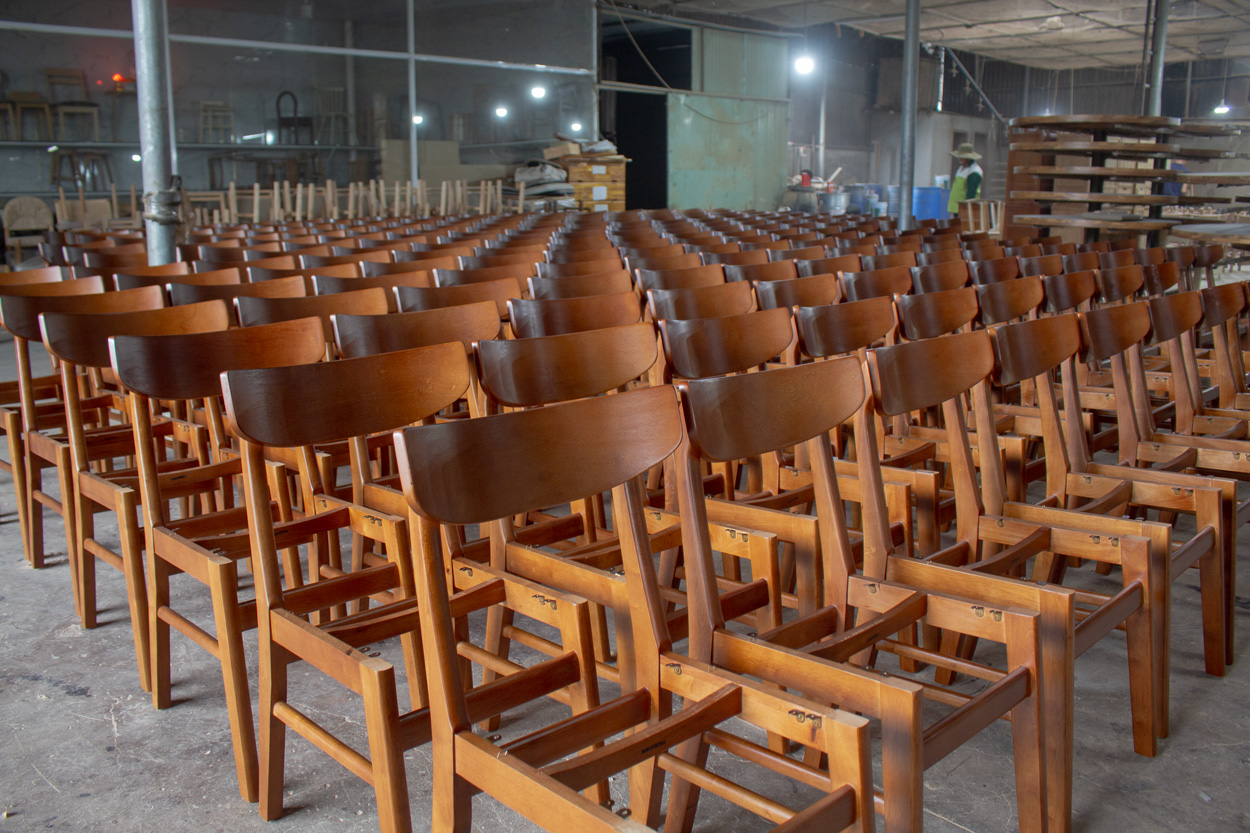Vietnam Furniture Shipping Cost: What You Need to Know
Are you a business exploring vietnam furniture shipping cost to plan your international orders? This article provides a detailed breakdown of every cost component of Vietnam furniture shipping cost, from inland transportation and ocean freight to import duties.. It also analyzes how these charges impact overall profitability and suggests strategies to optimize expenses while ensuring timely global delivery. We invite your company to read on and gain practical insights.
Inland Transportation Costs (Inland Trucking)
Inland trucking is one of the first and most influential factors in the total Vietnam furniture shipping cost. Inland trucking refers to the cost of transporting goods from the manufacturing facility to a seaport in Vietnam. This is the first step in the journey of an export shipment and plays a crucial role in ensuring timely delivery.
The party responsible for this cost depends on the chosen Incoterms (shipping terms):
| Incoterms | Responsibility for Inland Transportation |
| FOB
(Free on Board) |
Under FOB terms, the inland movement remains part of the seller’s share of the Vietnam furniture shipping cost. The manufacturer or furniture factory covers all inland transportation expenses from the factory to the port, including export procedures and related charges at origin in Vietnam. The buyer assumes responsibility for costs only once the goods have been loaded onto the vessel. This arrangement is common in furniture exports, especially when businesses wish to manage international logistics through their own freight forwarders. |
| EXW (Ex-Works) | Ex-Works assigns full responsibility for transportation—from the factory to the final destination—to the buyer. This means the partner must arrange inland transport, handle export customs formalities, and bear all risks starting from the factory warehouse. |
| CIF / DDP / DAP | The seller not only covers domestic transportation costs but also handles most or all of the international logistics process. The upcoming Incoterms 2025 is expected to maintain the principles of the DDP (Delivered Duty Paid) term, under which the seller bears full responsibility for delivering the goods to the agreed destination, including export and import customs procedures, duties, and transportation costs. This term remains widely preferred by businesses that aim to deliver goods directly to customers while minimizing the buyer’s involvement in import formalities. |
In practice, inland transportation costs can vary significantly depending on the distance from the factory to the port, the type of cargo (full container or less-than-container load), and traffic conditions.
Amid fluctuating fuel prices, negotiating clear terms for Vietnam furniture shipping cost allows businesses to avoid unexpected expenses while maintaining control and flexibility throughout the supply chain.
>>> Read more: Vietnam vs China Furniture Cost: Which Option Is the Most Optimal?
Local Charges at Origin (Vietnam Ports)
Local charges at Vietnamese ports cover all fees incurred when goods are delivered to the export port. Local charges at Vietnamese ports are a critical part of the Vietnam furniture shipping cost structure, bridging inland transport and ocean freight. This step acts as the bridge between inland transportation and ocean freight, playing a critical role in ensuring shipments are loaded onto vessels on schedule.
Common fees include:
- Container hauling fees
- THC (Terminal Handling Charges for loading/unloading containers)
- CFS fees (for less-than-container loads)
- Seal fees for container security
- Container cleaning fees
- Export customs documentation and related charges
While these fees may seem minor individually, collectively they can range from a few million to tens of millions of VND per shipment, depending on cargo type, number of containers, and the chosen port. For example, a 20-foot container of furniture can cost an estimated $500 to $1,000 in port fees — not a small amount for exporting goods.

Under FOB (Free on Board) terms, most local charges at the Vietnamese port are covered by the furniture export factory. This allows businesses to more accurately calculate vietnam furniture shipping cost without worrying about unexpected origin charges. Conversely, with EXW (Ex-Works), the buyer must handle and pay all these fees directly, coordinating with Vietnamese logistics providers.
To proactively estimate total costs, many companies use a landed cost calculator furniture to determine the full expense from factory to the foreign port. This approach helps minimize unforeseen surcharges, particularly during peak export seasons.
Ocean Freight
Ocean freight refers to the cost of transporting goods by container ship from ports in Vietnam to destination ports in the importing country. It represents the largest component of Vietnam’s furniture shipping fees and is highly sensitive to fluctuations in the international shipping market.
Freight rates depend on multiple factors, including fuel prices (bunker), port congestion, seasonal shipping demand, and geopolitical issues affecting maritime routes. When comparing CIF and FOB pricing, businesses should understand that CIF includes both ocean freight and insurance arranged by the seller, but does not cover costs at the destination port. In contrast, FOB gives the buyer full control over the choice of shipping line and services, while the buyer handles international transport themselves.
Under FOB terms, importing businesses work directly with shipping lines or freight forwarders to book space and pay for the freight. For instance, shipping from Vietnam to Long Beach usually costs a few thousand USD per container, varying by season and container size (20ft or 40ft).
During peak periods or logistics crises, such as Lunar New Year, Black Friday, or times of global port congestion, ocean freight rates can spike significantly. At such times, a 40ft container from Vietnam to the U.S. West Coast can reach USD 3,000 – 4,500, while shipments to Northern Europe may exceed USD 5,000 per container.
Destination Charges
Destination charges are the fees that businesses must settle when goods arrive at the importing country’s port. These costs typically include:
- Container unloading fees (THC at the destination port)
- Offloading charges from the vessel
- Delivery order processing fees
- Customs inspection charges
- Temporary storage fees, if applicable
Even when using FOB, CIF, or DDP terms, it is essential for businesses to understand the structure of destination port charges to plan their budgets accurately.
For example, shipments from Vietnam to Long Beach, USA, may incur additional fees such as the Harbor Maintenance Fee (HMF) and Merchandise Processing Fee (MPF), which first-time importers often overlook. These charges can add several hundred USD per container on top of standard port handling costs.

Being aware of these fees at the destination helps companies better estimate the total cost of shipping, avoiding unexpected markups. In the context of fluctuating global logistics costs, a clear understanding of destination charges is a key factor in optimizing vietnam furniture shipping cost.
Last Mile Delivery
Last mile delivery is the final stage of the shipment journey, transporting goods from the destination port to your company’s warehouse, store, or distribution center. This step can be one of the most variable and sometimes costly parts of vietnam furniture shipping cost, as it is influenced by factors such as:
- Fuel prices
- Local infrastructure
- Road tolls
- Delivery time restrictions in different countries…
For example, in the United States, moving furniture from the Port of Long Beach to inland states can cost several times more than the ocean freight segment. Costs rise further when shipments cross multiple states or require expedited services. In Europe, countries like Germany and France apply significant road tolls and environmental fees, which can noticeably increase the total shipping cost from Vietnam.
For contracts under DDP terms, sellers cover last mile delivery, allowing partners to receive goods directly without handling local logistics. However, these costs should still be carefully evaluated to compare whether using local delivery services or relying on international logistics providers is more efficient.
Understanding last mile delivery costs helps businesses better estimate total Vietnam furniture shipping cost, avoid unexpected charges, and maintain predictable delivery schedules, ensuring smoother operations and consistent margins for international furniture imports.
>>> Read more: Where to Buy Wholesale Furniture for Resale? – Southeast Asia.
Import Duty & VAT
Beyond vietnam furniture shipping cost, import duties and local VAT in the destination market directly impact the total landed cost of furniture. These rates vary depending on the country, product type, and applicable bilateral or multilateral trade agreements. Understanding these taxes is crucial for accurate budgeting and avoiding unexpected expenses.
| Market | Applicable Import Duty & VAT on Furniture |
| European Union (EU) | Import duty on many wooden furniture items and parts may range from 0 % to 2.7 % depending on product classification and country of origin. |
| United States | Basic import duties are determined by HTS/HS classification. In certain cases, anti-dumping or countervailing duties could be applied if investigations find unfair trade practices. These are less common for furniture from Vietnam, but origin fraud or mixed-component imports may trigger them |
| Canada, Australia, Japan | Each country applies its own duty schedule; local VAT / consumption tax often falls within a range of ~5 % to 20 %, depending on the product and national tax rules. |
Hidden Shipping Fees Furniture
In practice, many unexpected hidden shipping fees furniture can arise during the export process. These charges often cause the vietnam furniture shipping cost to exceed initial estimates, potentially disrupting budgets and delaying delivery schedules if businesses are unprepared.

Common hidden fees include:
- Peak Season Surcharge (PSS): Applied when container demand spikes, typically during year-end periods, major holidays, or when empty containers are scarce. PSS can increase shipping costs by several dozen to several hundred USD per container.
- Demurrage and Detention Fees: Charged when containers are not returned or picked up within the free time allowed by the shipping line. For bulky furniture, longer unloading times can quickly increase these fees.
- Schedule Changes, Name Changes, and Unexpected Customs Inspections: Such fees often arise from customs requirements or last-minute adjustments to shipment plans. In markets like the US and EU, random inspections are relatively frequent, leading to additional costs for storage and document handling.
To minimize hidden fees, businesses should request that forwarders or shipping lines provide a detailed breakdown of all potential charges during the quotation stage. Carefully reviewing payment terms, free container time, and booking change policies is essential to maintain control over shipping costs. By proactively managing these variables, companies can better predict the total vietnam furniture shipping cost and avoid surprises that impact both budgets and delivery timelines.
How to Optimize Vietnam Furniture Shipping Cost Effectively
Managing vietnam furniture shipping cost is not just about finding the cheapest ocean freight. It requires a comprehensive strategy, including selecting the right route, shipping method, negotiating terms, and optimizing packaging. When implemented properly, businesses can reduce logistics expenses by 10–20% annually.
Effective optimization strategies include:
- Choose the right route and port: Avoid ports with congestion or high destination port charges. For example, when exporting to the US West Coast, Oakland sometimes offers lower fees and less congestion compared to Long Beach.
- Combine FOB terms with clear negotiation of local charges: FOB allows buyers to choose carriers or forwarders independently, but companies should finalize port charges in advance to avoid unexpectedly high fees.
- Work with furniture-specialized forwarders: These providers understand the handling of bulky, easily scratched items and often secure better rates due to larger shipment volumes.
- Consolidate multiple orders (LCL consolidation): Combining multiple smaller shipments to the same market reduces the cost per CBM and maximizes container utilization.
- Optimize packaging and container loading: Design compact packaging and fully utilize container space to minimize the number of containers required, thereby reducing container shipping cost Vietnam.
By following these strategies, companies not only control vietnam furniture shipping cost but also enhance predictability and efficiency in international furniture logistics, ensuring timely delivery and safeguarding profit margins.
>>> Read more: Aurora Craft: Cost Savings with Furniture from Manufacturer in Vietnam.
Conclusion
The vietnam furniture shipping cost typically comprises multiple components, including inland transportation, ocean freight, port charges, taxes, and various hidden fees. Understanding each element allows businesses to better manage risks, accurately estimate delivery timelines, and control total shipping expenses.
Should any questions arise regarding shipping costs, Aurora Craft is ready to assist. We provide detailed guidance on all aspects of furniture shipping, as well as insights into our in-house production processes, helping partners make informed decisions and streamline their supply chain.
About Aurora Craft
Aurora Craft is a Vietnamese furniture manufacturer with over 15 years of experience, specializing in exporting premium furniture. We have successfully collaborated with numerous international clients from the US, Europe, Australia, and other major markets.
With a production facility spanning 10,000 m² and export capacity of up to 60 containers per month, Aurora Craft can reliably fulfill large-scale orders while maintaining consistent quality. Contact Aurora Craft today to receive professional consultation and detailed quotations, ensuring a smooth and cost-efficient international furniture shipping experience.




